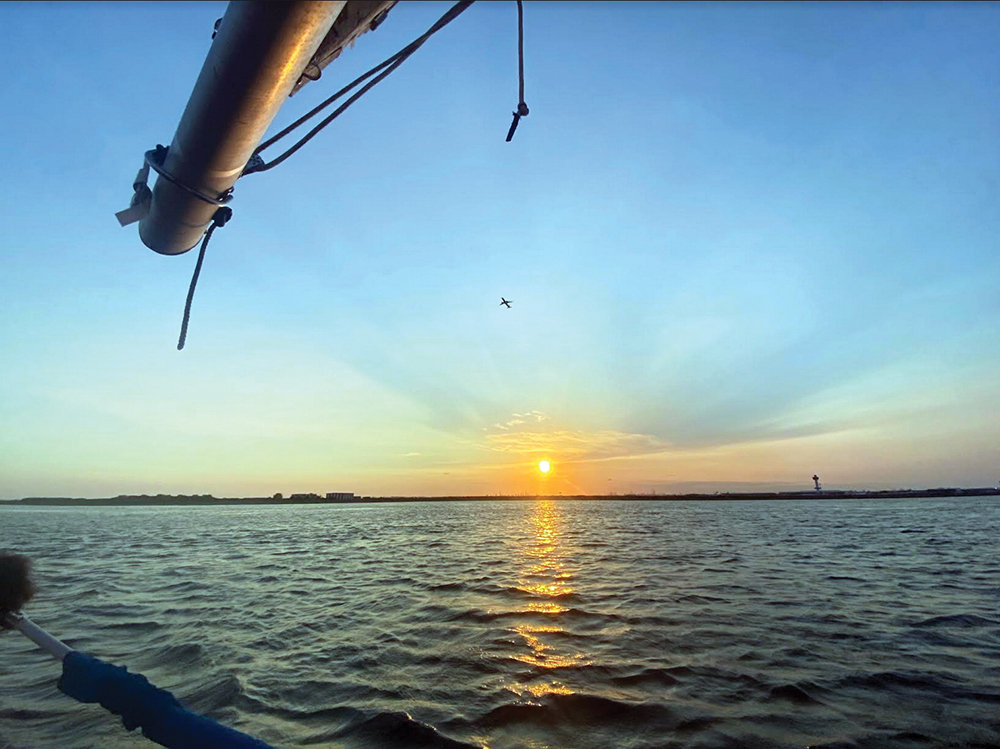Someday, my baby, when I am a man
And others have taught me the best that they can
They’ll sell me a suit, then cut off my hair,
And send me to work in tall buildings …
— John Hartford
I’m tempted to quote T-Pain: “I’m on a boat, mother … .” But I’ll spare you. I was on a boat on my vacation, though, a funky single-masted sloop owned by a sailing co-op my son belongs to in Rockaway Beach. We went out one evening with eight locals for a sunset sail in Jamaica Bay. The only sounds were gulls, congenial conversation, and the occasional snap of the mainsail. As the sun fell to the orange horizon, we took pictures. I noticed when I enlarged the photos that you could see the entire skyline of Manhattan below the setting sun, far and wee in the distance.
It brought to mind a story I’d read in The New York Times earlier in the week called “A Full Return to the Office? Does ‘Never’ Work for You?” The current return-to-office rate for office workers around the country is 43 percent, but in New York City, recent data puts the number of workers who have returned to the office five days a week at 8 percent. Most of the buildings in that impressive skyline are half-full at best.
At-home workers cite Covid fears, the cost of commuting, gasoline prices, childcare, and the inability to concentrate in a cubicle/desk situation as reasons to continue working remotely. Management fears that if their workers stay home their organizations will lose the benefits of cooperative brainstorming, a teamwork ethic, and, yes, a lack of direct oversight — not to mention that companies continue to have to pay for their office facilities whether they’re used or not.
But it’s clear the pandemic has unmasked a myth: that people need oversight to be productive. Different organizations are trying different ways forward. Some are experimenting with three-day-a-week office hours or flex scheduling around meetings, school schedules, etc. Others are downsizing office space to a few meeting areas and shared workstations.
It’s all in flux, but one thing seems certain: The office out-migration is going to greatly impact the nation’s cities, where commercial real estate has traditionally been a driver of business, employment, income, and tax revenues. Full Downtown office buildings mean full restaurants, full bars for after-work happy hours, full parking facilities, and bustling retail. Now, maybe not so much.
But in a weird way, the work-from-home trend may favor a city like Memphis. For years, we’ve marveled at Nashville’s building boom, its Downtown seemingly permanently decorated with a half-dozen cranes attached to under-construction office towers. But if you’ve been to Downtown Nashville at night lately, you’ve seen a congested, noisy, tourist hell-hole. Housing prices are skyrocketing. A recent piece in the Nashville Post reported that “6 percent of homebuyers moving to Memphis in the first quarter were from Nashville, twice the rate of the same period in 2021. In April, the typical home in Nashville sold for $455,000, compared to $280,000 in Memphis.” Welcome to Bluff City, cowpokes.
Downtown Memphis is anything but overbuilt. We’ve still got the finest 1970s skyline in America. Plus a pyramid. Sterick Building, anyone? But maybe we got lucky. Nashville, New York, Austin, and all those other “it” cities are going to have to figure out what to do with all those shiny “big empties.” Not us. And let’s not forget that thousands of Memphians don’t have the privilege of working from home. Warehouses, factories, hospitals, retail cash registers, bars, grocery stores, delivery trucks, etc. don’t exist without people leaving their homes and clocking in. Without these essential workers, everything breaks down. The Memphis economy is filled with those kinds of jobs. Which, it turns out, is a good thing in the eventual post-pandemic world.
So, maybe the future is livability and affordability. Maybe the future is funkiness and soul and big trees and big water rather than tall, gleaming — empty — buildings. Maybe it’s finally our turn. Maybe we’ve been there all along, patiently waiting for the world to find us — out there on the horizon, far and wee in the distance.
